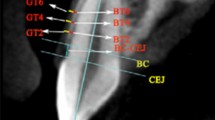Abstract
Introduction A relationship between thin gingiva and thin buccal bone has been proposed but concrete evidence for this is lacking. This study was undertaken to assess the reliability of measuring gingival thickness in estimating the buccal bone thickness.
Objectives To answer the following PICO question: do periodontally healthy individuals exhibit any correlation between gingival biotype and buccal/labial/facial bone thickness?
Data sources and selection An electronic search was performed in PubMed and Embase databases. English language articles that have met the inclusion and exclusion criteria were selected. Only observational studies were considered. Since the studies have demonstrated heterogeneity, conducting a meta-analysis was not possible, so the results were synthesised using a vote counting method and narrative synthesis.
Data synthesis After screening the titles and abstracts, 13 studies which met the study criteria were included in the systematic review. Out of these 13 studies, nine studies assessed only the maxillary anterior/premolars; one study assessed the mandibular anterior, and three studies assessed both maxillary and mandibular anterior/premolars.
Conclusions The findings of this systematic review indicated that the gingival biotype may be a reliable indicator for estimating the thickness of buccal bone in maxillary anterior. However, its relation to the buccal bone thickness in mandible is unclear.
This is a preview of subscription content, access via your institution
Access options
Subscribe to this journal
Receive 4 print issues and online access
$259.00 per year
only $64.75 per issue
Buy this article
- Purchase on Springer Link
- Instant access to full article PDF
Prices may be subject to local taxes which are calculated during checkout

Similar content being viewed by others
References
Olssoin M, Lindhe J, Marinello C. On the relationship between crown form and clinical features of the gingiva in adolescents. J Clin Periodontol 1993; 20: 570-577.
Seibert J, Lindhe J. Esthetics and periodontal therapy. In Textbook of clinical periodontology. pp 477-514. Munksgaard Copenhagen: Wiley-Blackwell, 1989.
Müller H P, Eger T. Gingival phenotypes in young male adults. J Clin Periodontol 1997; 24: 65-71.
Kao R T, Pasquinelli K. Thick versus thin gingival tissue: A key determinant in tissue response to disease and restorative treatment. J Calif Dent Assoc 2002; 30: 521-526.
Korostoff J, Al-Abdulhadi M, Stathopoulou P G. The use of cone beam computed tomography to assess periodontal biotype. Curr Oral Health Rep 2018; 5: 202-209.
Small P, Tarnow D, Cho S. Gingival recession around wide-diameter versus standard-diameter implants: a 3-to 5-year longitudinal prospective study. Pract Proced Aesthet Dent 2001; 13: 143-146.
Cook D R, Mealey B L, Verrett R G et al. Relationship between clinical periodontal biotype and labial plate thickness: an in vivo study. Int J Periodontics Restorative Dent 2011; 31: 345-354.
Bushman B, Cooper H, Hedges L. The handbook of research synthesis. New York: Russell Sage Foundation Publications, 1994.
Stein J M, Lintel-Hoping N, Hammacher C, Kasaj A, Tamm M, Hanisch O. The gingival biotype: measurement of soft and hard tissue dimensions - a radiographic morphometric study. J Clin Periodontol 2013; 40: 1132-1139.
Shao Y, Yin L, Gu J, Wang D, Lu W, Sun Y. Assessment of periodontal biotype in a young Chinese population using different measurement methods. Sci Rep 2018; DOI: 10.1038/s41598-018-29542-z.
Rossell J, Puigdollers A, Girabent-Farrés M. A simple method for measuring thickness of gingiva and labial bone of mandibular incisors. Quintessence Int 2015; 46: 265-271.
Ganji K K, Alswilem R O, Abouonq A O, Alruwaili A A, Alam M K. Noninvasive evaluation of the correlation between thickness of the buccal bone and attached gingiva of maxillary premolars. J Esthet Restor Dent 2019; 31: 240-245.
Esfahanizadeh N, Daneshparvar N, Askarpour F, Akhoundi N, Panjnoush M. Correlation between bone and soft tissue thickness in maxillary anterior teeth. J Dent (Tehran) 2016; 13: 302-308.
Frumkin N, Via S, Klinger A. Evaluation of the width of the alveolar bone in subjects with different gingival biotypes: A prospective cohort study using cone beam computed tomography. Quintessence Int 2017; 48: 209-216.
Amid R, Mirakhori M, Safi Y, Kadkhodazadeh M, Namdari M. Assessment of gingival biotype and facial hard/soft tissue dimensions in the maxillary anterior teeth region using cone beam computed tomography. Arch Oral Biol 2017; DOI: 10.1016/j.archoralbio.2017.02.021.
Fu J H, Yeh C Y, Chan H L, Tatarakis N, Leong D J, Wang H L. Tissue biotype and its relation to the underlying bone morphology. J Periodontol 2010; 81: 569-574.
Hwang D, Wang H L. Flap thickness as a predictor of root coverage: a systematic review. J Periodontol 2006; 77: 1625-1634.
Shirmohammadi A, Faramarzie M, Lafzi A. A clinical evaluation of anatomic features of gingiva in dental students in Tabriz, Iran. J Dent Res Dent Clin Dent Prospects 2008; 2: 90-94.
Wheeler R C. Textbook of dental anatomy and physiology. Philadelphia: WB Saunders, 1940.
Kois J C. The restorative-periodontal interface: biological parameters. Periodontol 2000 1996; 11: 29-38.
Morris M L. The position of the margin of the gingiva. Oral Surg Oral Med Oral Pathol 1958; 11: 969-984.
Tian Y-l, Liu F, Sun H-J et al. Alveolar bone thickness around maxillary central incisors of different inclination assessed with cone-beam computed tomography. Korean J Orthod 2015; 45: 245-252.
Vandana K, Savitha B. Thickness of gingiva in association with age, gender and dental arch location. J Clin Periodontol 2005; 32: 828-830.
Acar B, Kamburoğlu K. Use of cone beam computed tomography in periodontology. World J Radiol 2014; 6: 139-147.
La Rocca A P, Alemany A S, Levi P Jr, Juan M V, Molina J N, Weisgold A S. Anterior maxillary and mandibular biotype: relationship between gingival thickness and width with respect to underlying bone thickness. Implant Dent 2012; 21: 507-515.
Younes F, Eghbali A, Raes M, De Bruyckere T, Cosyn J, De Bruyn H. Relationship between buccal bone and gingival thickness revisited using non-invasive registration methods. Clin Oral Implants Res 2016; 27: 523-528.
Frost N A, Mealey B L, Jones A A, Huynh-Ba G. Periodontal biotype: gingival thickness as it relates to probe visibility and buccal plate thickness. J Periodontol 2015; 86: 1141-1149.
Khoury J, Ghosn N, Mokbel N, Naaman N. Buccal bone thickness overlying maxillary anterior teeth: a clinical and radiographic prospective human study. Implant Dent 2016; 25: 525-531.
Kim Y J, Park J M, Kim S et al. New method of assessing the relationship between buccal bone thickness and gingival thickness. J Periodontal Implant Sci 2016; 46: 372-381.
Acknowledgments
We would like to express our gratitude to Professor Mark Bartold for his constant support and encouragement.
Author information
Authors and Affiliations
Contributions
Raghavendra Vamsi Anegundi: data sources, data selection, data extraction, data synthesis and interpretation, preparing the manuscript and proof reading. Santhosh B Shenoy: data selection, data synthesis and interpretation, preparing the manuscript and proof reading. Anahita Punj: data selection, data synthesis and interpretation, preparing the manuscript and proof reading.
Corresponding author
Ethics declarations
None.
Rights and permissions
About this article
Cite this article
Anegundi, R., Shenoy, S. & Punj, A. Gingival biotype as an indicator for the buccal bone thickness - a systematic review of the literature. Evid Based Dent (2021). https://doi.org/10.1038/s41432-021-0206-y
Received:
Accepted:
Published:
DOI: https://doi.org/10.1038/s41432-021-0206-y



